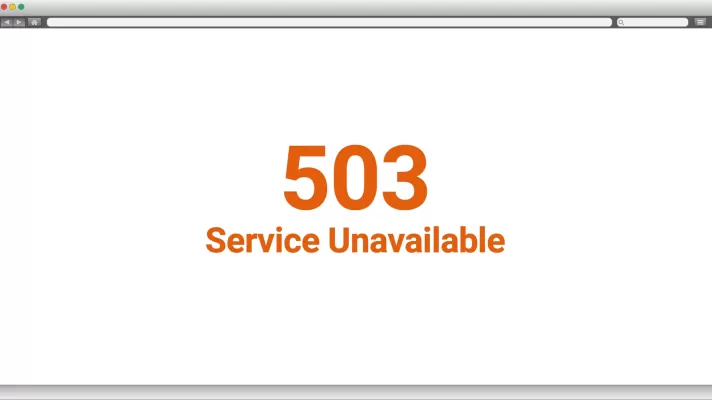
If you’ve ever come across an error message like “Error 503,” you’re likely familiar with the frustrating and bewildering experience it brings.
Introduction
If you’ve ever come across an error message like “Error 503,” you’re likely familiar with the frustrating and bewildering experience it brings. It leaves you feeling confused and irritated, as you’re left in the dark about what’s happening. Moreover, it’s natural to be a bit anxious; you may worry that you somehow caused this error and fear it’s negatively impacting your readership and damaging your digital marketing efforts. In this article, we will delve into the world of Error 503, providing insights on what it means and equipping you with the knowledge to resolve HTTP 503 error messages should they arise in the future.
What Is Error 503?
Distinct from similar errors such as Error 502, an Error 503, denoted as “Service Unavailable,” is an HTTP error that materializes when a server is presently unable to fulfill a requested action. The error message itself tends to be quite cryptic, lacking specific details about the underlying issue. Nevertheless, since it pertains to server-related problems, you can generally assume that your website visitors are encountering the same error. This underscores the significance of promptly addressing and resolving this issue.
Understanding the Causes of Error 503
- The initial step when encountering an HTTP error 503 is to understand its root cause. Potential reasons for its occurrence encompass:
- Maintenance issues: These can hinder a website from establishing a connection with its server.
- Malicious DDoS attacks: Deliberate and harmful distributed denial-of-service attacks may trigger this error.
- Server overload: When a server is excessively burdened to the extent that it can’t fulfill incoming requests, it can result in a 503 error.
In numerous instances, a 503 server error is transient, resolving itself once the server regains the capacity to process requests. Nevertheless, recurrent 503 errors can be troublesome and detrimental to your user experience. Therefore, it’s imperative for digital marketers and website owners to be well-versed in addressing these issues.
How to Fix Error 503
Are you prepared to resolve an ongoing problem with persistent 503 service errors on your website? Here’s the solution for addressing recurring HTTP 503 error issues.
Troubleshooting steps
The encouraging news for website owners experiencing Error 503 messages is that there are actionable steps you can take to diagnose and resolve the problem. Begin with these strategies:
- Server Reboot: Similar to how rebooting your router can fix various home Wi-Fi issues, restarting your server can have a similar effect. If the error is recent, start here to determine if it persists.
- Server Status Check: Verify if your server is currently undergoing routine maintenance, as this could be a reason for the error.
- Firewall Inspection: Examine your firewall settings for potential issues. Occasionally, misconfigured or deactivated settings can mistakenly identify legitimate access requests as DDoS attacks.
- Error Log Examination: Review your server-side error logs meticulously. Look out for alerts or any useful information that might pinpoint the issue.
- Code Review: If all else fails, scrutinize your website’s code for bugs, as these can easily trigger an Error 503 message.
Resolving common error 503 scenarios
In addition to the above suggestions, you can try the following resolutions to commonly experienced HTTP error 503 issues. If the error is attributed to overload problems, consider expanding available resources to handle the excess load. One effective method is to distribute incoming traffic across multiple servers, known as load balancing.
In the case of a maintenance-related issue, exercise patience until it resolves itself. Subsequently, explore your server’s configuration options to determine if you can manually control the timing of future updates.
Review your settings not only for your firewall but also for any other software applications that might disrupt requests to or from the server, and make adjustments as necessary.
For iPhone users and other mobile device owners, HTTP error 503 can present in distinctive ways. Let’s delve into the specifics of addressing a service unavailable error under these circumstances.
Check your software
If you encounter an error 503 problem on an iPhone or another mobile device, it could be due to conflicts in your software. Therefore, it’s essential to verify that you have the most up-to-date versions of your device’s operating system and applications.
Clear your cache
Cache conflicts often contribute to error 503 messages on mobile devices. If it’s been some time since you last cleared your device’s cache, consider performing a quick cleanup before trying again.
Check your connectivity
Unstable Wi-Fi or unreliable mobile data coverage can also result in error codes, so it’s crucial to verify your connection. If you’re currently connected to Wi-Fi, consider switching to mobile data (or vice versa) to determine if it resolves the problem.
Check your app settings
Similar to server issues on websites, it’s vital to confirm the absence of app conflicts or settings problems. Make sure that security apps, browsers, and other relevant applications have the required permissions to send and receive essential signals.
How to Prevent Error 503
While some server errors, like a 503, may occur due to uncontrollable factors, you can diminish their probability by taking proactive measures. Frequent errors have the potential to impact user experience, which, consequently, can have adverse effects on your website’s rankings.
Here are some suggestions to keep in mind and explore:
- Ensure your server access can handle your current website traffic. It’s common for web administrators and site owners to scale up as their websites grow in popularity.
- Confirm that your content delivery networks (CDNs) and caching mechanisms are both up-to-date and capable of meeting the demand.
- Maintain vigilant oversight of your server’s infrastructure. Establish a regular maintenance routine and adhere to it to minimize potential issues.
- Familiarize yourself with the intricacies of the best technical SEO practices to decrease the chances of coding errors and related problems.
Conclusion
Dealing with error 503 messages and similar issues can be frustrating, but they’re manageable. To navigate them effectively, have a reliable troubleshooting routine, implement preventive measures, and optimize your website’s performance.
A dependable website hosting platform is vital for preventing error 503. It offers robust server infrastructure, ample resources, and efficient load balancing to ensure uninterrupted service even during high traffic periods.
Consider exploring Stage from Rock Content, a top-tier solution that simplifies website hosting and maintenance. With Stage, the technical aspects are handled for you, allowing you to focus on other priorities. Learn more about Stage today and experience the benefits!






